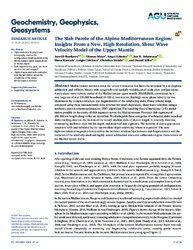The Slab Puzzle of the Alpine-Mediterranean Region: Insights From a New, High-Resolution, Shear Wave Velocity Model of the Upper Mantle
Meier, Thomas
Hamada, Mona
Cristiano, Luigia
DOI: https://doi.org/10.1029/2020GC008993
Persistent URL: http://resolver.sub.uni-goettingen.de/purl?gldocs-11858/9035
Persistent URL: http://resolver.sub.uni-goettingen.de/purl?gldocs-11858/9035
El-Sharkawy, Amr; Meier, Thomas; Lebedev, Sergei; Behrmann, Jan H.; Hamada, Mona; Cristiano, Luigia; Weidle, Christian; Köhn, Daniel, 2020: The Slab Puzzle of the Alpine-Mediterranean Region: Insights From a New, High-Resolution, Shear Wave Velocity Model of the Upper Mantle. In: Geochemistry, Geophysics, Geosystems, Band 21, 8, DOI: 10.1029/2020GC008993.
 |
Dokument öffnen: |
Mediterranean tectonics since the Lower Cretaceous has been characterized by a multiphase subduction and collision history with temporally and spatially variable, small-scale plate configurations. A new shear wave velocity model of the Mediterranean upper mantle (MeRE2020), constrained by a very large set of over 200,000 broadband (8–350 s), interstation, Rayleigh wave, phase velocity curves, illuminates the complex structure and fragmentation of the subducting slabs. Phase velocity maps computed using these measurements were inverted for depth-dependent, shear wave velocities using a stochastic particle-swarm-optimization (PSO) algorithm. The resulting three-dimensional (3-D) model makes possible an inventory of slab segments across the Mediterranean. Fourteen slab segments of 200–800 km length along-strike are identified. We distinguish three categories of subducted slabs: attached slabs reaching down to the bottom of the model; shallow slabs of shorter length in downdip direction, terminating shallower than 300 km depth; and detached slab segments. The location of slab segments are consistent with and validated by the intermediate-depth seismicity, where it is present. The new high-resolution tomography demonstrates the intricate relationships between slab fragmentation and the evolution of the relatively small and highly curved subduction zones and collisional orogens characteristic of the Mediterranean realm.
Statistik:
ZugriffsstatistikSammlung:
Schlagworte:
surface wave tomographyParticle Swarm Optimization
Mediterranean upper mantle
slab fragmentations
slab gaps and tears
This is an open access article under the terms of the Creative Commons Attribution License, which permits use, distribution and reproduction in any medium, provided the original work is properly cited.

